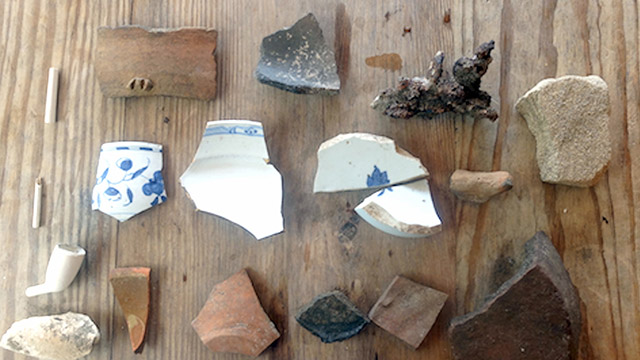Beach erosion from Hurricane Maria last year has led to an archeological discovery in the Caribbean island nation of Dominica.
Excavations over the summer conducted by Northwestern University anthropologist Mark Hauser and Douglas Armstrong of Syracuse University revealed the foundation of a tavern or a warehouse used in the early 17th century and abandoned in the early 18th century. This study, and associated historical research, was carried out in cooperation with Lennox Honychurch of Dominica’s Island Heritage Initiative.
This trading post, or factory, is the first of its kind discovered in Woodford Hill, Dominica, West Indies. It was a permanent structure built on a European design.
“It appears to be associated with a village documented on early maps that included several buildings and a church,” Hauser said. “The site appears to have been abandoned suddenly in the 1720s.”
Excavations beneath the building show an even earlier settlement that has been dated somewhere between 1477 and 1640.
According to Hauser, Sir Francis Drake and John Hawkins, who initiated England’s involvement in the trans-Atlantic slave trade, described a village in the vicinity of Woodford Hill where the indigenous people grew tobacco and English and French men bartered knives, hatchets and saws.
“The late 16th and early 17th centuries saw dramatic shifts in global balances of power and economy, and small islands in the eastern Caribbean were at its epicenter,” Hauser said. “Individuals such as Drake and Hawkins played important roles in these changes. Even more important were the indigenous peoples upon whom they relied for trade in tobacco, cotton and other commodities that were in demand.”
Hauser said sites associated with this global shift, as well as the people who made it possible, have been an elusive part of the archaeological record.
Artifacts recovered from this settlement include European ceramics, glass beads, shell pendants, quartz crystal, trade bells, ‘Cayo’ earthenware and several novel syncretic artifacts, the result of the fusion of ideas and techniques in production from a combination of indigenous, African and European traditions, he explained.
“This significant new discovery provides an opportunity to examine the elusive record of early interactions and trade among the indigenous, African and European peoples of Dominica and the Caribbean,” Hauser said. “Cayo earthenware are believed to have been made by the immediate ancestors of the indigenous Kalinago people of Dominica.”
The presence of quartz and a substance believed to be the solidified pitch of the La Suau tree indicate that traders such as Drake and Hawkins did not so much develop new markets for European wares, but rather tapped into preexisting and complex circuits of exchange involving raw and worked semiprecious stones including jasper, green-stone, flint and quartz.
Hauser was on a research trip in April in Dominica when local anthropologist Lennox Honychurch asked him to visit and document the Woodford Hill site that he discovered after Hurricane Maria exposed numerous artifacts on the beachfront. Hauser then returned in July with Syracuse University anthropologist Douglas Armstrong to excavate and document the most vulnerable parts of the site.
Hauser, Armstrong and Honychurch plan to return to the site in 2019 to expand their excavations.
“We hope to uncover more parts of the trade port and see what kinds of settlements predated this early European venture,” Hauser says. “The research will attempt to understand some fundamental questions -- how large was the town, who lived there and what did everyday life look like for its residents.”
According to an 18th-century map, the sherds and foundation exposed by Hurricane Maria and excavated by the team most likely represent part of a much larger 17th- and 18th-century village that needs to be explored. Hauser says sites such as these are at risk from coastal erosion brought about by changing climatic conditions and water levels.
Northwestern has had a decade-long engagement with the island nation through Hauser’s work, documenting the archaeological record of slavery, colonialism and the African diaspora and its impact on the environment. This project was partially funded through a Northwestern research grant.


